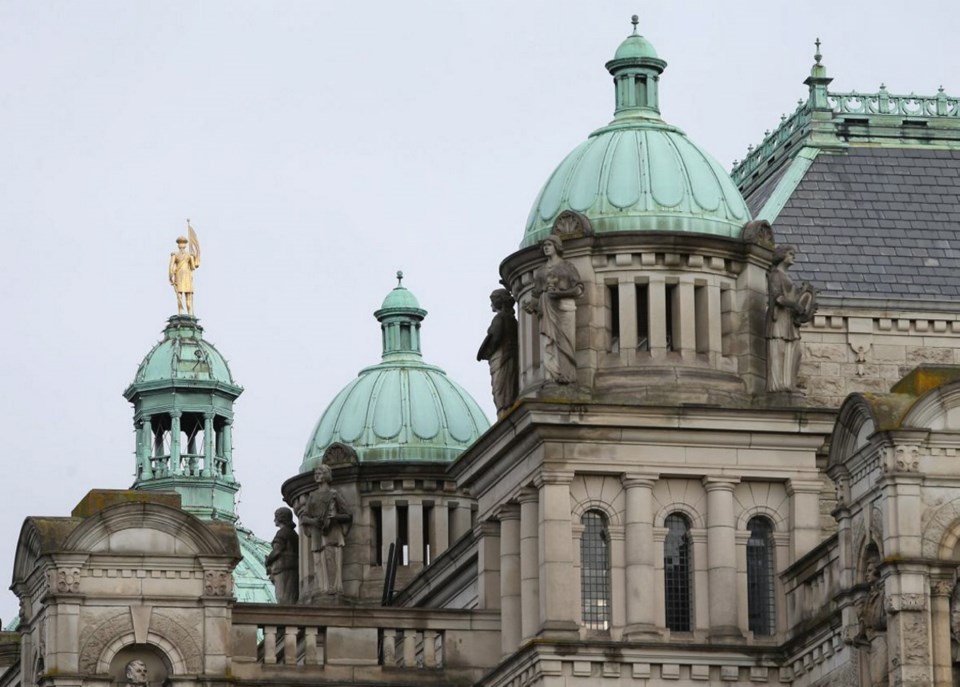 It’s a classic retail strategy that has worked as well for B.C. governments over the past 60 years as it has for merchants since the invention of commerce.
It’s a classic retail strategy that has worked as well for B.C. governments over the past 60 years as it has for merchants since the invention of commerce.
Show the clients one price, then offer them a better one. Client feels better getting a “discount” and goes away happy.
The official B.C. version of the gambit is known as the homeowner grant. Homeowners get their tax notice from their municipalities listing the price they’ll be levying for all the services provided. Grumbling ensues.
Then near the bottom of the form they see the box where the government of B.C. rides in to the rescue, offering to subtract hundreds of dollars from the total for those who qualify.
Finance Minister Mike de Jong made the annual adjustment to the qualification threshold on Tuesday, and the move illustrates yet again how stretched out of shape the real estate market is. The basic grant (now $570) has always applied to owner-occupied homes up to a certain value, on the philosophy that after a certain point wealthy people in mansions shouldn’t be entitled to big tax benefits. (There are variations for seniors, disabled and those living outside southwestern B.C.) So the cut-off point for the full basic grant is always of interest. A brief history of the phase-out threshold shows how far the government has had to move to keep up with the market: 2003 — $525,000; 2004 — $585,000; 2005 — $685,000; 2006 — $780,000; 2007 — $905,000.
It crossed the million-dollar mark in 2008 and held steady for three years then started climbing again, reaching $1.285 million by 2012. The government lowered it 15 per cent in 2014 to save money, but then it bounced back up to $1.2 million in 2016.
De Jong made history of sorts on Tuesday by jacking the threshold up $400,000, to $1.6 million. A 33 per cent hike in one year is the largest increase in the 60-year life of the program. It reflects the reality that many people living in $1.59-million homes in Metro Vancouver are just regular taxpayers and shouldn’t be considered wealthy.
But the number is so absurdly high, it’s hard to comprehend. The relativity between owners of homes worth $1.6 million and renters in the city gets stretched to the snapping point.
It also costs a bundle. Over the past seven years, the cost of the homeowner grant to the treasury has risen from $717 million to $809 million, even though the amount of the actual grant has remained the same. That reflects the increase in home ownership and also the continuing effort to make the grant as widely available as possible.
The giant increase in the threshold will push the estimated cost this year to $821 million, the largest jump in the overall cost of the program since 2011. There’s an ongoing argument about whether that kind of money could be better spent on people who need it more.
But advocates for a redesign overlook the fact that more than 90 per cent of homeowners qualify for it. It’s a direct, high-visibility gift from government to hundreds of thousands of taxpayers (voters), which makes it very popular. So the homeowner grant, which is enshrined in legislation, has survived several changes of government and become bigger and better over the years.
De Jong noted he mused years ago about changing the program to make it more efficient, and “it didn’t go over very well.”
NDP housing critic David Eby said the B.C. Liberals took so long to make the change that highly leveraged people were panicking at losing all or part of the grant. And the provincewide threshold is being used mostly to help people in one region.
The reason for the change was to prevent recipients mostly in Metro Vancouver from losing the grant. It will have much less impact on Vancouver Island, only on owners of $1.2-million homes whose assessment notices climbed above that mark this year.
And given that the market has subsided slightly from the July 1 price point, there’s a fair chance of the threshold dropping next year.



